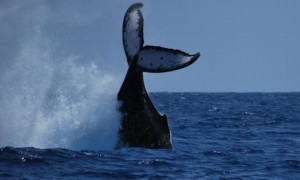Aloha,
We woke up to rain and blustery winds on Thursday, which meant we weren’t able to take our guests on any morning whale watch cruises. We did get to go out for the Whales and Cocktails Cruise though, and it seemed like the humpbacks were happy to see us. We saw spouts in every direction we looked. For awhile, it seemed like all the action must be taking place below the surface because all we saw were whales surfacing, taking a few breaths, and then diving again. But it’s February now — height of the season for whale watching off our coast — so it wasn’t long before we got to see some breaching from a few adult humpbacks. We also saw tail lobs and peduncle throws. We found a couple of different Mom/Baby pods — both accompanied by escorts. And lots of pods of two and three adult Humpbacks charging around on the surface.
Have a great weekend — I’ll send out a recap on Monday!
Claire
Captain Claire’s Humpback Fact of the Day: I was at the airport Thursday afternoon, when a guest from one of last week’s Whale Watch cruises who apparently recognized me even though I wasn’t dressed in my Ocean Sports uniform walked over and said, “I just can’t remember…what was that word you used to describe the back of the whale”? I answered that we call the region between the whales’ flukes and his main body, a “peduncle”…but why? So I looked it up. The word “peduncle” comes from the Latin word “ped” which means foot. It was first used to describe the stalk of a flower, fruit, or tumor. I guess that makes sense…the back part of the whale does sort of look like a stalk, bearing the whale’s wide flukes.

